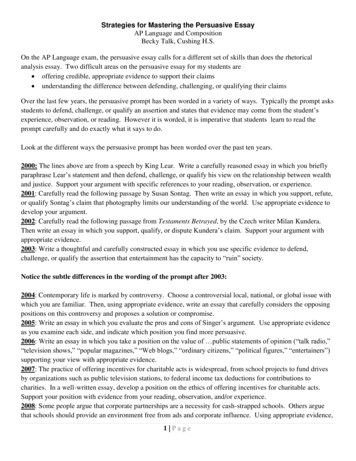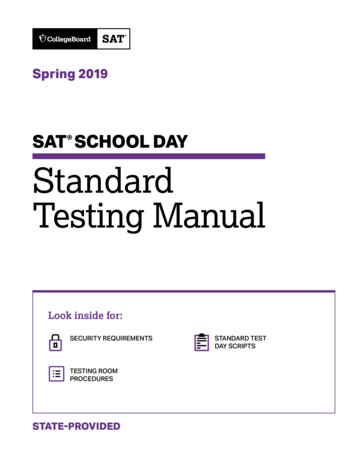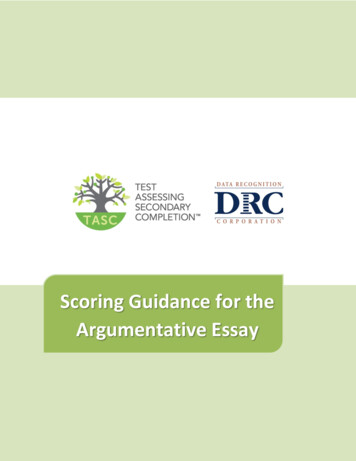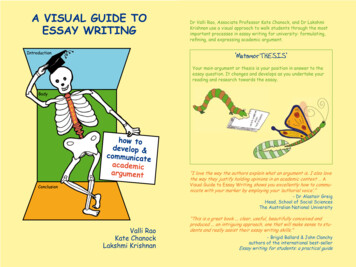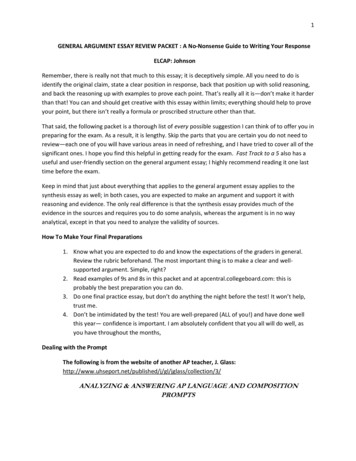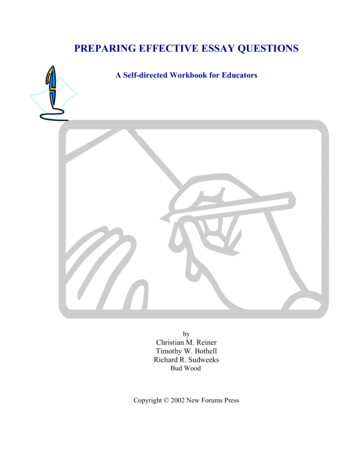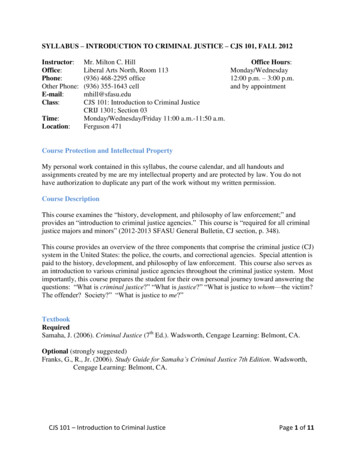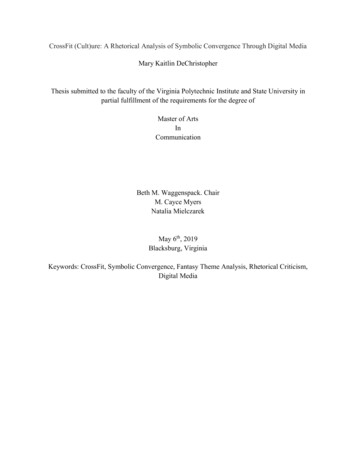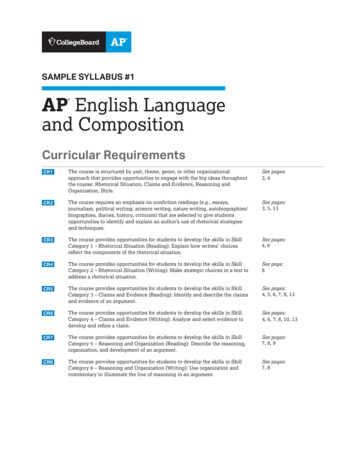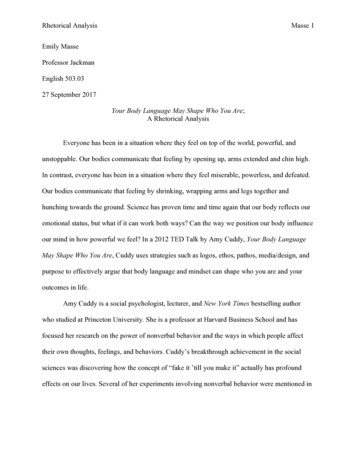
Transcription
Rhetorical AnalysisMasse 1Emily MasseProfessor JackmanEnglish 503.0327 September 2017Your Body Language May Shape Who You Are;A Rhetorical AnalysisEveryone has been in a situation where they feel on top of the world, powerful, andunstoppable. Our bodies communicate that feeling by opening up, arms extended and chin high.In contrast, everyone has been in a situation where they feel miserable, powerless, and defeated.Our bodies communicate that feeling by shrinking, wrapping arms and legs together andhunching towards the ground. Science has proven time and time again that our body reflects ouremotional status, but what if it can work both ways? Can the way we position our body influenceour mind in how powerful we feel? In a 2012 TED Talk by Amy Cuddy, Your Body LanguageMay Shape Who You Are, Cuddy uses strategies such as logos, ethos, pathos, media/design, andpurpose to effectively argue that body language and mindset can shape who you are and youroutcomes in life.Amy Cuddy is a social psychologist, lecturer, and New York Times bestselling authorwho studied at Princeton University. She is a professor at Harvard Business School and hasfocused her research on the power of nonverbal behavior and the ways in which people affecttheir own thoughts, feelings, and behaviors. Cuddy’s breakthrough achievement in the socialsciences was discovering how the concept of “fake it ’till you make it” actually has profoundeffects on our lives. Several of her experiments involving nonverbal behavior were mentioned in
Rhetorical AnalysisMasse 2this TED Talk, where participants utilized powerful body stances and weak body stances in aseries of tests to determine how physical assertions affect our mentality. (“Amy Cuddy”)Cuddy noticed that, physiologically, hormones had a great deal to do with our nonverbalexpressions of power and dominance. The hormone testosterone relates to feelings of dominanceand the hormone cortisol relates to levels of stress. The overwhelmingly clear outcome of thistest was that participants in a “high-power” physical pose (shoulders square, arms wide, overallstrong stature) had a 20% increase in testosterone and a 25% decrease in cortisol. Participants in“low-power” physical poses (hunched over, arms crossed, curled up) had a 10% decrease intestosterone and a 15% increase in cortisol. In her studies, Cuddy ultimately proved that bodylanguage can shape who you are and how you feel at a given time in your life. In delivering herfindings and overall argument via TED Talk, Cuddy utilized multiple strategies in persuading heraudience to use this potentially life-changing information.Logos, or logic-based reasoning, appears throughout the first two thirds of this speech togive a solid scientific background to Cuddy’s argument that body language and mindset shapeswho you are and what you get out of life. The first kinds of logic-based reasoning Cuddy usesare facts and data through examples. She first offers the findings of a Tufts University researcherNalini Ambady, who studied how people react to body language in patient-physician encounters.Reference to this study is followed by research from Alex Todorov at Princeton, who found thata political candidate’s body language determines the outcome of many U.S. elections. Cuddyexpands upon the facts and data with examples which align our behavior with that of the animalkingdom in the following example, “What are nonverbal expressions of power and dominance?So in the animal kingdom, they are about expanding. So you make yourself big What do we dowhen we feel powerless? We close up so again, both animals and humans do the same thing”
Rhetorical AnalysisMasse 3(Cuddy). These facts and examples help paint a picture as to how body language and nonverbalbehavior have been studied before and how those findings are relevant to understanding herargument.Cuddy also uses cause and effect based reasoning to deliver the main points of herspeech. “If an individual needs to take over an alpha role sort of suddenly, within a few days,that individual’s testosterone has gone up significantly and his cortisol has dropped significantly.So we have this evidence, both that the body can shape the mind, and also that role changes canshape the mind.” Through this example, she shows that hormones within the body can effect themind. To conclude her speech, Cuddy argues that the cost of taking two minutes in a “highpower pose” can lead to big benefits and positive changes in a person’s life. “The last thing I’mgoing to leave you with is this. Tiny tweaks can lead to big changes. So, this is two minutes. Twominutes.” It is repeated to the audience that two minutes of an altered physical stance is all that ittakes to configure your brain to cope in the best way during a stressful situation. This cost is veryminimal to the benefits it could reap, so it is an effective persuasive strategy to conclude herargument.Another effective tool that Cuddy used throughout the beginning of her talk was languageto establish ethos, or credibility as a speaker. After opening the speech with visual anecdotes, atthe three-minute mark Cuddy included, “I’m a social psychologist. I study prejudice, and I teachat a competitive business school, so it was inevitable that I would become interested in powerdynamics.” In once sentence, she delivers a small portion of both personal experience andresearch credentials in this field, in addition to being a respected professor. This one sentencelays the platform for her audience to believe and respect what she has to say, and can rely on herbeing knowledgeable about the topic. Before she produced this sentence for personal ethos, she
Rhetorical AnalysisMasse 4cited two researchers and their early studies in nonverbal behavior, demonstrating an appeal toexperts. Additionally, three minutes later, she adds, “so my main collaborator, Dana Carney,who’s at Berkeley, and I really wanted to know ” This gives the impression that it is not justCuddy studying this and coming up with conclusions, but is working with a respected researcherfrom Berkeley on board with these ideas. This furthers her personal credentials and appeal toexperts.Cuddy uses pathos, emotion based statements, in narrative form to convince her audiencethat body language shapes your mindset and outcomes in life. This use of personal storytellingcame towards the end of her speech trailing an influx of logos and ethos. The audience alreadybelieves she is a credible source who has presented a logical argument, so all that is left to driveher argument home is the emotional appeal. “I want to tell you a little story about being animposter and feeling like I’m not supposed to be here [story about car accident brain injurydepleting her IQ, making it almost impossible to finish college] I felt entirely powerless, Iworked and worked I graduated from college and ended up at Princeton even if you’reterrified you must say ‘Oh my gosh, I’m doing it. Like, I have become this. I am actually doingthis.’” The audience had a positive emotional reaction to her extremely personal story withapplause and cheering.Cuddy went on to tell the story of a student of hers at Harvard, who never spoke in classand felt completely defeated and ready to fail. This touched Cuddy personally as she reflectedupon her own struggles and how mindset and determination helped her against all odds. Tearingup, she continued, “[the student] said ‘I’m not supposed to be here.’ And that was the momentfor me I realized, oh my gosh I don’t feel like that anymore. But she does, and I get thatfeeling. She is supposed to be here! Like, she can fake it, she can become it.” Cuddy ultimately
Rhetorical AnalysisMasse 5helped this student achieve in the classroom simply by changing her mindset. In these stories,she strategically utilizes the “fear of loss” emotion, where many people can relate to feelinglonely, out of place, and vulnerable at some point in their lives. She also demonstrates the“promise of gain” emotion, where the kind of life you want to live can be achieved throughmindset and body language. Both kinds of emotional appeals were placed the end of the speechbefore tying her ideas together in conclusion. This format is particularly powerful because itemphasizes the authenticity of her discoveries through real-life examples by tugging at theaudiences’ heartstrings.Media and design played a role in the delivery of the speaker’s argument throughout theTED Talk. At the beginning, imagery on presentation screens helped display some of Cuddy’smain talking points and introduce the topic she was about to delve into. These images werepresented in humorous and easy-to-understand ways. She used the screens to demonstrate thebody stances often referenced throughout the speech, seen below in Figures 1 and 2. Cuddy alsoused her own body to demonstrate examples within her argument, seen below in Figures 3 and 4.Figure 1Figure 2
Rhetorical AnalysisFigure 3Masse 6Figure 4Another way in which Cuddy utilized media and design was towards the end to highlight keyconcepts and takeaways from her argument. She did this by displaying simple words and phrasesas a means of concluding her speech, seen below in Figures 5 and 6.Figure 5Figure 6When delivering a speech, an author or speaker has a rhetorical choice whether to use some sortof imagery or slides to accompany their arguments. In this case, Cuddy’s use of imagery helps inmaking her logic-based examples transparent and encourages her audience to take the knowledgethey gained with them, apply it in their own lives, and share it with others.Similarly, that rhetorical choice in media design helped her achieve the purpose of herargument. Cuddy’s purpose, which she explicitly stated in her speech was, “I want to ask youfirst, you know, both try the power posing, and also I want to ask you to share the science,because this is simple. I don’t have ego involved in this. (Laughter) Give it away. Share it with
Rhetorical AnalysisMasse 7people, because the people who can use it the most are the ones with no resources and notechnology and no status and no power it can significantly change the outcomes of their life.”Cuddy uses moral ethos in this case as well by saying she wants her studies and hard work inresearch to be put to good use by the public. Ultimately, that was the purpose of this TED Talk,to spread the word about the power of body language and inspire thought and action. Utilizingboth speech and and visuals, her audience is shown and encouraged “what to do next,” in easysteps. This allows them to participate rather than be passive listeners.We are all fascinated with body language. We experience it every second of every daythrough others and within ourselves. Body language has the power to relay our emotions, manyof us understand that. However, it can be even more fascinating and useful to understand yourbody language can effect your emotions and actions. For many, this realization can be lifechanging. Cuddy’s research and assertion that body language can shape mindset, who you are,and your outcomes in life is effective in its structure as a speech and its delivery of a compellingand persuasive argument.
Rhetorical AnalysisMasse 8Works Cited“Amy Cuddy.” Wikipedia, Wikimedia Foundation, 17 Sept. 2017,en.wikipedia.org/wiki/Amy Cuddy. Accessed 20 Sept. 2017.Cuddy, Amy. “Your Body Language May Shape Who You Are.” TED Conferences, LLC, June2012,www.ted.com/playlists/171/the most popular talks of all?gclid mfmZXu9cqIAqMkCWE1KAM4aUeRoCbNkQAvD BwE. Accessed 18 Sept. 2017.
this TED Talk, where participants utilized powerful body stances and weak body stances in a series of tests to determine how physical assertions affect our mentality. (“Amy Cuddy”) Cuddy noticed that, physiologically, hormones had a great deal to
